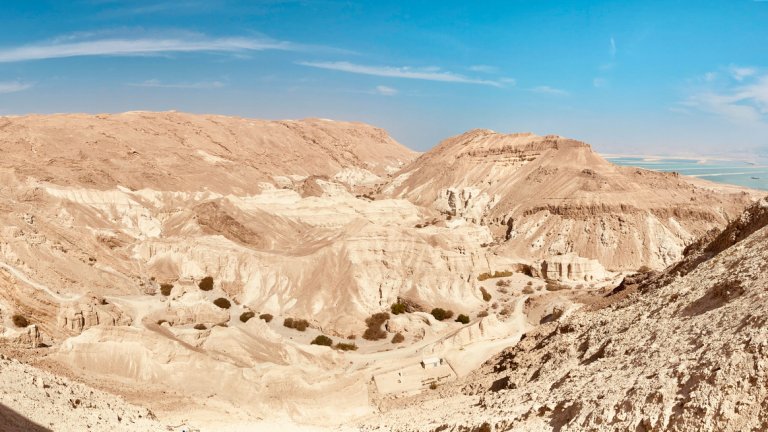It was found next to the entrance to a cave in the Ain Gedi nature reserve, with three pomegranates on one side and a cup on the other
A rare 2,000-year-old coin dating back to the time of the Judean-Roman Wars has been found in the Judean Desert, the Israel Antiquities Authority (ISA) said, citing the Israeli news agency TPS.
Three pomegranates are depicted on one side of the silver half-shekel coin, and a cup is depicted on the other. The words “Holy Jerusalem” are also written.
According to ISA, the coin dates from the year 66 or 67. Jews were under the rule of the Roman Empire, so the minting of coins was a defiant expression of national identity, the ISA said.
Only the Roman emperor had the right to mint coins, and Roman coins almost always depicted the reigning emperor and animals. Yaniv David Levi, a specialist in numismatics at the antiquities office, explained that the half shekel was a special tax that the Jews paid for the upkeep of the Temple and the procurement of animals for sacrifices.
“Coins from the first year of the revolt, like the one found in the Judean Desert, are rare,” Levy said. “During the time of the Second Temple, pilgrims paid a tax of half a shekel to the Temple. The accepted currency for the payment of this tax for nearly 2,000 years was the Tyrian shekel. When the first revolt broke out, the rebels issued these replacement coins which bore the inscriptions ‘Israeli shekel”, “half shekel” and “quarter shekel”.
Temple worship appears to have continued during the rebellion, and these coins were also used by the rebels for this purpose. The discovery was announced during the week of the Ninth of Av, a somber day for Jews commemorating the destruction of the First and Second Temples. This occurs on the ninth day of the Hebrew month of Av (July or August in the Gregorian calendar). During the holiday, which begins Wednesday night at sundown, Jews fast to commemorate the tragic events.
The coin was found while exploring caves in the Judean Desert. It was discovered next to the entrance of a cave in the Ain Gedi nature reserve, which is located near the Dead Sea. “Obviously there was a rebel who wandered the desert rocks and dropped the precious half shekel treasure, and fortunately we were able to find it 2,000 years later and return it to the public,” said archaeologist Haggai Hamer.













 English
English French
French Spanish
Spanish German
German Dutch
Dutch Italian
Italian Danish
Danish Portuguese
Portuguese Greek
Greek Russian
Russian Swedish
Swedish Bulgarian
Bulgarian Hungarian
Hungarian Catalan
Catalan Ukrainian
Ukrainian Polish
Polish Basque
Basque Chinese (Simplified)
Chinese (Simplified) Japanese
Japanese Hebrew
Hebrew Arabic
Arabic Swahili
Swahili Amharic
Amharic Irish
Irish Afrikaans
Afrikaans Albanian
Albanian Armenian
Armenian Azerbaijani
Azerbaijani Belarusian
Belarusian Bengali
Bengali Bosnian
Bosnian Cebuano
Cebuano Chichewa
Chichewa Chinese (Traditional)
Chinese (Traditional) Corsican
Corsican Croatian
Croatian Czech
Czech Esperanto
Esperanto Estonian
Estonian Filipino
Filipino Finnish
Finnish Frisian
Frisian Galician
Galician Georgian
Georgian Gujarati
Gujarati Haitian Creole
Haitian Creole Hausa
Hausa Hawaiian
Hawaiian Hindi
Hindi Hmong
Hmong Icelandic
Icelandic Igbo
Igbo Indonesian
Indonesian Javanese
Javanese Kannada
Kannada Kazakh
Kazakh Khmer
Khmer Korean
Korean Kurdish (Kurmanji)
Kurdish (Kurmanji) Kyrgyz
Kyrgyz Lao
Lao Latin
Latin Latvian
Latvian Lithuanian
Lithuanian Luxembourgish
Luxembourgish Macedonian
Macedonian Malagasy
Malagasy Malay
Malay Malayalam
Malayalam Maltese
Maltese Maori
Maori Marathi
Marathi Mongolian
Mongolian Myanmar (Burmese)
Myanmar (Burmese) Nepali
Nepali Norwegian
Norwegian Pashto
Pashto Persian
Persian Punjabi
Punjabi Romanian
Romanian Samoan
Samoan Scottish Gaelic
Scottish Gaelic Serbian
Serbian Sesotho
Sesotho Shona
Shona Sindhi
Sindhi Sinhala
Sinhala Slovak
Slovak Slovenian
Slovenian Somali
Somali Sundanese
Sundanese Tajik
Tajik Tamil
Tamil Telugu
Telugu Thai
Thai Turkish
Turkish Urdu
Urdu Uzbek
Uzbek Vietnamese
Vietnamese Welsh
Welsh Xhosa
Xhosa Yiddish
Yiddish Yoruba
Yoruba Zulu
Zulu